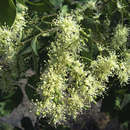fr
noms dans le fil d’Ariane


Die kleinvalsmopanie (Guibourtia conjugata)[1] is 'n immergroen boom wat in die suide van Mosambiek, Pafuri/Punda Maria in die Krugerwildtuin en ook in die Hwange-gebied van Zimbabwe voorkom. Dit is inheems aan Suid-Afrika, Zimbabwe, Mosambiek en Zambië.
Dit is 'n bladwisselende struik of boom wat 18 m hoog kan word. Die hout word veral vir heiningpaaltjies gebruik, maar dit is ook geskik vir vloere of meubels. Die kernhout is donkerbruin en steek af teen die spinthout wat liggeel is. Die hout is swaar en hard: die digtheid is 950–1100 kg/m³. Die semifosiele hars word as inhambane-kopal verkoop en in vernis gebruik.[2]
Die kleinvalsmopanie (Guibourtia conjugata) is 'n immergroen boom wat in die suide van Mosambiek, Pafuri/Punda Maria in die Krugerwildtuin en ook in die Hwange-gebied van Zimbabwe voorkom. Dit is inheems aan Suid-Afrika, Zimbabwe, Mosambiek en Zambië.
Dit is 'n bladwisselende struik of boom wat 18 m hoog kan word. Die hout word veral vir heiningpaaltjies gebruik, maar dit is ook geskik vir vloere of meubels. Die kernhout is donkerbruin en steek af teen die spinthout wat liggeel is. Die hout is swaar en hard: die digtheid is 950–1100 kg/m³. Die semifosiele hars word as inhambane-kopal verkoop en in vernis gebruik.
Guibourtia conjugata is a species of small to medium-sized trees from family Fabaceae that can be found in Mozambique, Zambia and Zimbabwe. The plants are growing in woods and along the river banks of Limpopo and Mpumalanga. The plant is 9 meters tall, with the leaves that can range from 3–5 cm in length and are ovated and a bit curved. The plant's flowers are either white or yellow coloured and are 5 mm in diameter. Their apex is rounded and is hairless.[1]
Guibourtia conjugata is a species of small to medium-sized trees from family Fabaceae that can be found in Mozambique, Zambia and Zimbabwe. The plants are growing in woods and along the river banks of Limpopo and Mpumalanga. The plant is 9 meters tall, with the leaves that can range from 3–5 cm in length and are ovated and a bit curved. The plant's flowers are either white or yellow coloured and are 5 mm in diameter. Their apex is rounded and is hairless.
Guibourtia conjugata là một loài thực vật có hoa trong họ Đậu. Loài này được (Bolle) J.Leonard miêu tả khoa học đầu tiên.[1]
Guibourtia conjugata là một loài thực vật có hoa trong họ Đậu. Loài này được (Bolle) J.Leonard miêu tả khoa học đầu tiên.